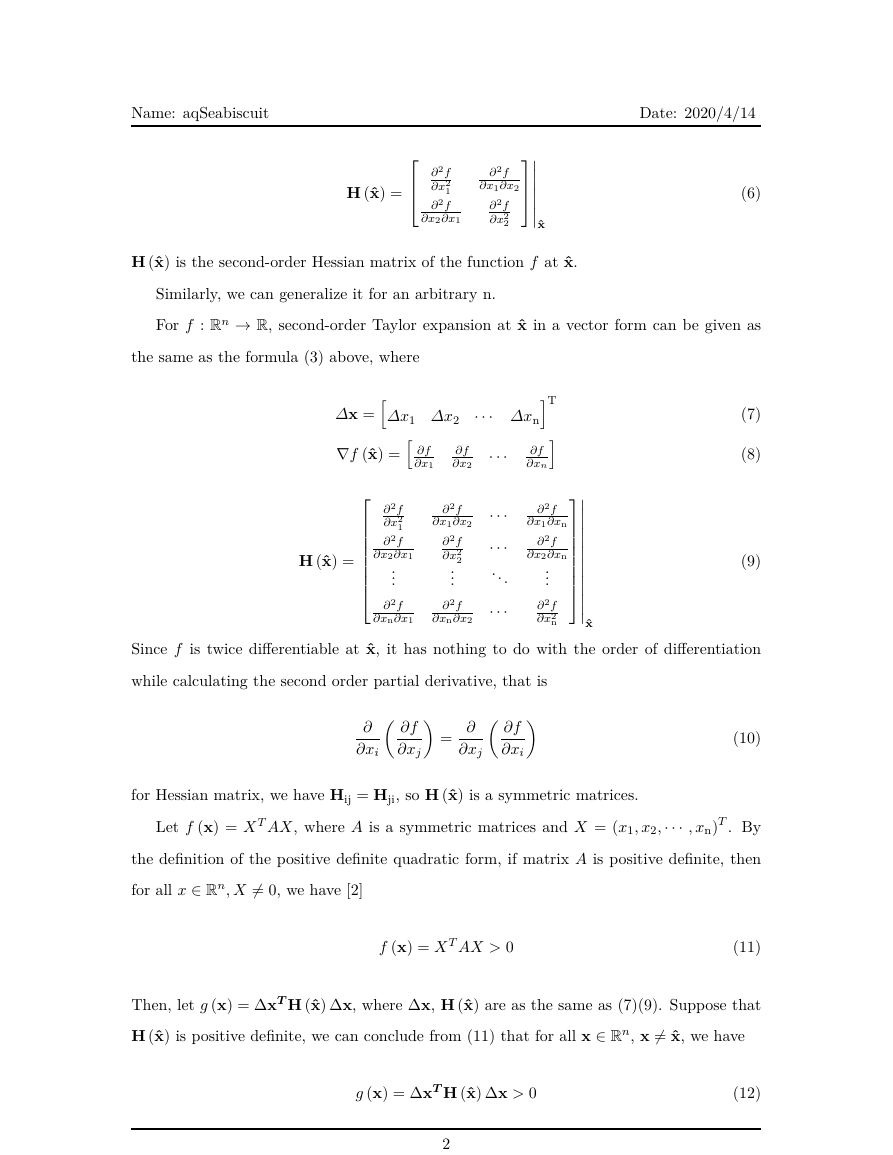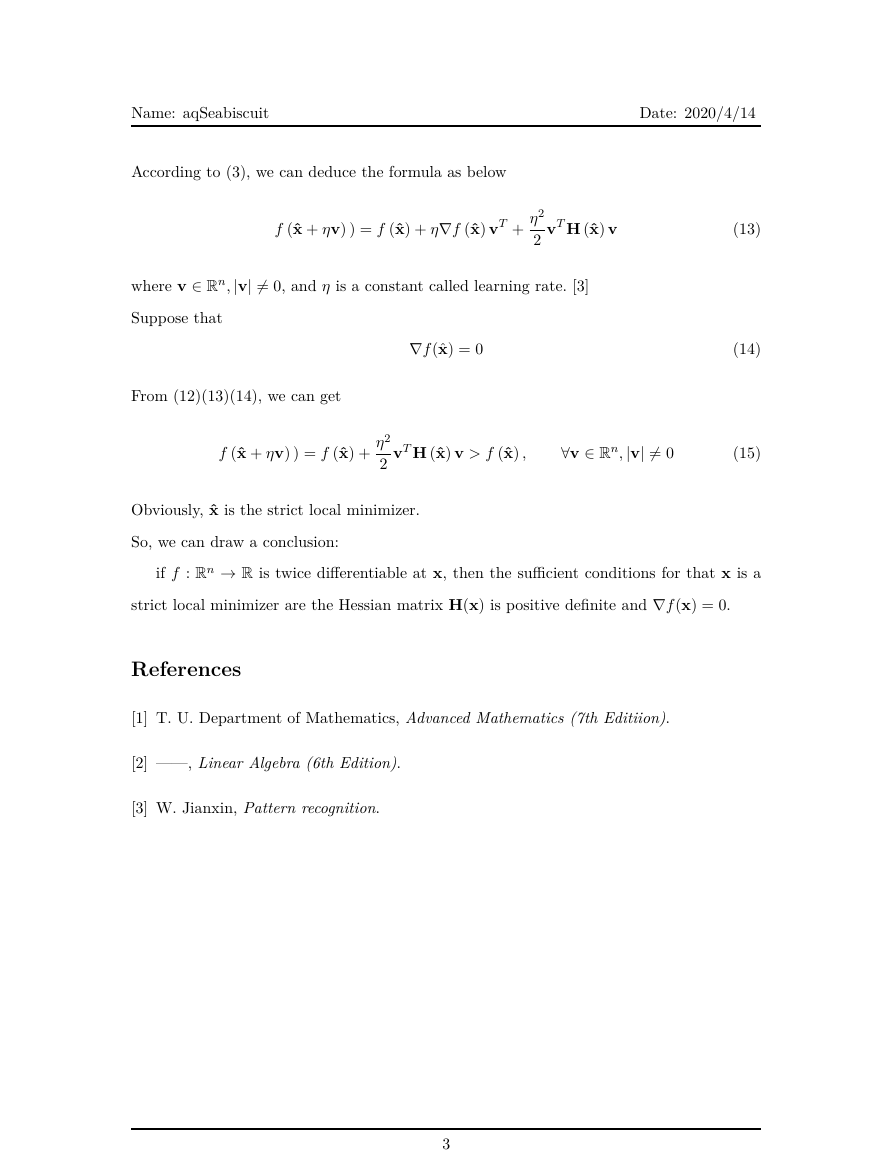Name: aqSeabiscuit
Date: 2020/4/14
Second-order sufficient optimality conditions
Problem:
Suppose that f : Rn → R is twice differentiable at x. Please show that x is a strict local
minimum if ∇f (x) = 0 and the Hessian matrix H(x) is positive definite.
Solve:
First consider the situation where n = 2, then the function f : Rn → R can be written as
f (x1, x2), x1, x2 ∈ R2. Suppose that f is twice differentiable at ˆx, where ˆx is ( ˆx1, ˆx2), then
we can expand the function f (x) near ˆx with the help of Taylor series up to second-order. [1]
It can be given as
f (x) = f (ˆx) +
+
∂f
∂x1
1
2
ˆx
∂2f
∂x2
1
∆x1 +
∂f
∂x2
ˆx
∆x2
∂2f
∆x2
1 + 2
ˆx
∂x1∂x2
ˆx
∆x1∆x2 +
∂2f
∂x2
2
∆x2
2
ˆx
where ∆x1 = x1 − ˆx1, ∆x2 = x2 − ˆx2.
Turn the Taylor expansion above into a matrix form, then
1A
0@ ∆x1
264 ∂2f
∆x1
∂x2
1
∂2f
ˆx
375
0@ ∆x1
1A
∆x1
ˆx
∂2f
∂x1∂x2
∂2f
∂x2
2
f (x) = f (ˆx) +
∂f
∂x1
∂f
∂x1
+
1
2
(∆x1 ∆x2)
Equivalently, it’s vector form can also be given as
∂x2∂x1
(1)
(2)
(3)
(4)
(5)
where
f (x) = f (ˆx) + ∇f (ˆx) ∆x +
∆xT H (ˆx) ∆x
1
2
h
∆x = [∆x1 ∆x2]T
∇f (ˆx) =
∂f
∂x1
∂f
∂x2
i
1
�
Name: aqSeabiscuit
264 ∂2f
∂x2
1
∂2f
∂x2∂x1
375
ˆx
∂2f
∂x1∂x2
∂2f
∂x2
2
H (ˆx) =
Date: 2020/4/14
(6)
H (ˆx) is the second-order Hessian matrix of the function f at ˆx.
Similarly, we can generalize it for an arbitrary n.
For f : Rn → R, second-order Taylor expansion at ˆx in a vector form can be given as
the same as the formula (3) above, where
h
h
∆x1 ∆x2
∆x =
∇f (ˆx) =
∂f
∂x1
∂f
∂x2
iT
i
··· ∆xn
···
∂f
∂xn
∂2f
∂x2
1
∂2f
∂x2∂x1
...
∂2f
∂2f
∂x1∂x2
∂2f
∂x2
2
...
∂2f
∂xn∂x1
∂xn∂x2
···
···
...
···
∂2f
∂x1∂xn
∂2f
∂x2∂xn
...
∂2f
∂x2n
266666664
H (ˆx) =
(7)
(8)
(9)
377777775
ˆx
Since f is twice differentiable at ˆx, it has nothing to do with the order of differentiation
while calculating the second order partial derivative, that is
∂
∂xi
∂f
∂xj
=
∂
∂xj
∂f
∂xi
(10)
for Hessian matrix, we have Hij = Hji, so H (ˆx) is a symmetric matrices.
Let f (x) = X T AX, where A is a symmetric matrices and X = (x1, x2,··· , xn)T . By
the definition of the positive definite quadratic form, if matrix A is positive definite, then
for all x ∈ Rn, X ̸= 0, we have [2]
f (x) = X T AX > 0
(11)
Then, let g (x) = ∆xT H (ˆx) ∆x, where ∆x, H (ˆx) are as the same as (7)(9). Suppose that
H (ˆx) is positive definite, we can conclude from (11) that for all x ∈ Rn, x ̸= ˆx, we have
g (x) = ∆xT H (ˆx) ∆x > 0
(12)
2
�
Name: aqSeabiscuit
Date: 2020/4/14
According to (3), we can deduce the formula as below
f (ˆx + ηv) ) = f (ˆx) + η∇f (ˆx) vT +
η2
2
vT H (ˆx) v
where v ∈ Rn,|v| ̸= 0, and η is a constant called learning rate. [3]
Suppose that
∇f (ˆx) = 0
From (12)(13)(14), we can get
(13)
(14)
f (ˆx + ηv) ) = f (ˆx) +
η2
2
vT H (ˆx) v > f (ˆx) ,
∀v ∈ Rn,|v| ̸= 0
(15)
Obviously, ˆx is the strict local minimizer.
So, we can draw a conclusion:
if f : Rn → R is twice differentiable at x, then the sufficient conditions for that x is a
strict local minimizer are the Hessian matrix H(x) is positive definite and ∇f (x) = 0.
References
[1] T. U. Department of Mathematics, Advanced Mathematics (7th Editiion).
[2] ——, Linear Algebra (6th Edition).
[3] W. Jianxin, Pattern recognition.
3
�






 2023年江西萍乡中考道德与法治真题及答案.doc
2023年江西萍乡中考道德与法治真题及答案.doc 2012年重庆南川中考生物真题及答案.doc
2012年重庆南川中考生物真题及答案.doc 2013年江西师范大学地理学综合及文艺理论基础考研真题.doc
2013年江西师范大学地理学综合及文艺理论基础考研真题.doc 2020年四川甘孜小升初语文真题及答案I卷.doc
2020年四川甘孜小升初语文真题及答案I卷.doc 2020年注册岩土工程师专业基础考试真题及答案.doc
2020年注册岩土工程师专业基础考试真题及答案.doc 2023-2024学年福建省厦门市九年级上学期数学月考试题及答案.doc
2023-2024学年福建省厦门市九年级上学期数学月考试题及答案.doc 2021-2022学年辽宁省沈阳市大东区九年级上学期语文期末试题及答案.doc
2021-2022学年辽宁省沈阳市大东区九年级上学期语文期末试题及答案.doc 2022-2023学年北京东城区初三第一学期物理期末试卷及答案.doc
2022-2023学年北京东城区初三第一学期物理期末试卷及答案.doc 2018上半年江西教师资格初中地理学科知识与教学能力真题及答案.doc
2018上半年江西教师资格初中地理学科知识与教学能力真题及答案.doc 2012年河北国家公务员申论考试真题及答案-省级.doc
2012年河北国家公务员申论考试真题及答案-省级.doc 2020-2021学年江苏省扬州市江都区邵樊片九年级上学期数学第一次质量检测试题及答案.doc
2020-2021学年江苏省扬州市江都区邵樊片九年级上学期数学第一次质量检测试题及答案.doc 2022下半年黑龙江教师资格证中学综合素质真题及答案.doc
2022下半年黑龙江教师资格证中学综合素质真题及答案.doc